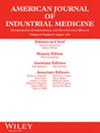Incidence of knee and hip joint replacement associated with cumulative exposure to physical factors at work
Abstract
Background
Knee osteoarthritis (OA) has been quite consistently associated with high physical workload and specific physical factors at work, while for hip OA, fewer studies are available, which still indicate possible associations with heavy lifting and physical workload. The objective of the study was to assess the association between exposure to workplace physical factors and incidence of knee and hip arthroplasty, as markers of severe OA in these joints.
Methods
The study population was composed of employees 25–60 years who participated in the Turin 2011 census. For each job held since 1995, exposure to physical factors was assigned to individuals in the cohort through a Job-Exposure Matrix constructed from the Italian O*NET database. Using Poisson regression models, the incidence of knee and hip arthroplasty for OA, identified through hospitalizations from 2012 to 2018, was examined in relation to cumulative exposure to 7 different physical hazards and a composite indicator of physical workload constructed from 17 physical factors (Ergo-Index).
Results
The risk of knee OA was significantly increased in the highest cumulative exposure quartile of physical workload (incidence rate ratio = 1.98, 95% confidence interval: 1.24–3.16) and of all single hazards examined, compared to the lowest quartile, with significant trends in risk with increasing exposure. In contrast, no association was found with hip OA, whose relative risks were close to or below one in all higher-exposure quartiles of physical workload and of each single hazard.
Conclusions
Our results indicate that exposure to physical hazards at work increases the likelihood of developing knee OA, but not hip OA.

 求助内容:
求助内容: 应助结果提醒方式:
应助结果提醒方式:


